Abstract
Coagulation factor V is a high molecular weight plasma glycoprotein that participates as a cofactor in the conversion of prothrombin to thrombin by factor Xa. A phage lambda gt11 Hep G2 cell cDNA expression library was screened by using an affinity-purified antibody to human factor V, and 11 positive clones were isolated and plaque-purified. The clone containing the largest cDNA insert contained 2970 nucleotides and coded for 938 amino acids, a stop codon, and 155 nucleotides of 3' noncoding sequence including a poly(A) tail. The coding region includes 651 amino acids from the carboxyl terminus that constitute the light chain of human factor Va and 287 amino acids that are part of the connecting region of the protein. The predicted amino acid sequence agreed completely with 147 amino acid residues that were identified by Edman degradation of cyanogen bromide peptides isolated from the light chain. During the activation of factor V, several peptide bonds are cleaved by thrombin, giving rise to a heavy chain, a connecting fragment(s), and a light chain. The light chain is generated by the cleavage of an Arg-Ser peptide bond. The amino acid sequence of the light chain is homologous (40%) with the carboxyl-terminal fragment (Mr, 73,000) of human factor VIII. Both fragments have a similar domain structure that includes a single ceruloplasmin-related domain followed by two C domains. The carboxyl terminus of the connecting region, however, shows no significant amino acid sequence homology with factor VIII. It is very acidic and contains a number of potential N-linked glycosylation sites. It also contains about 20 tandem repeats of nine amino acids.
Full text
PDF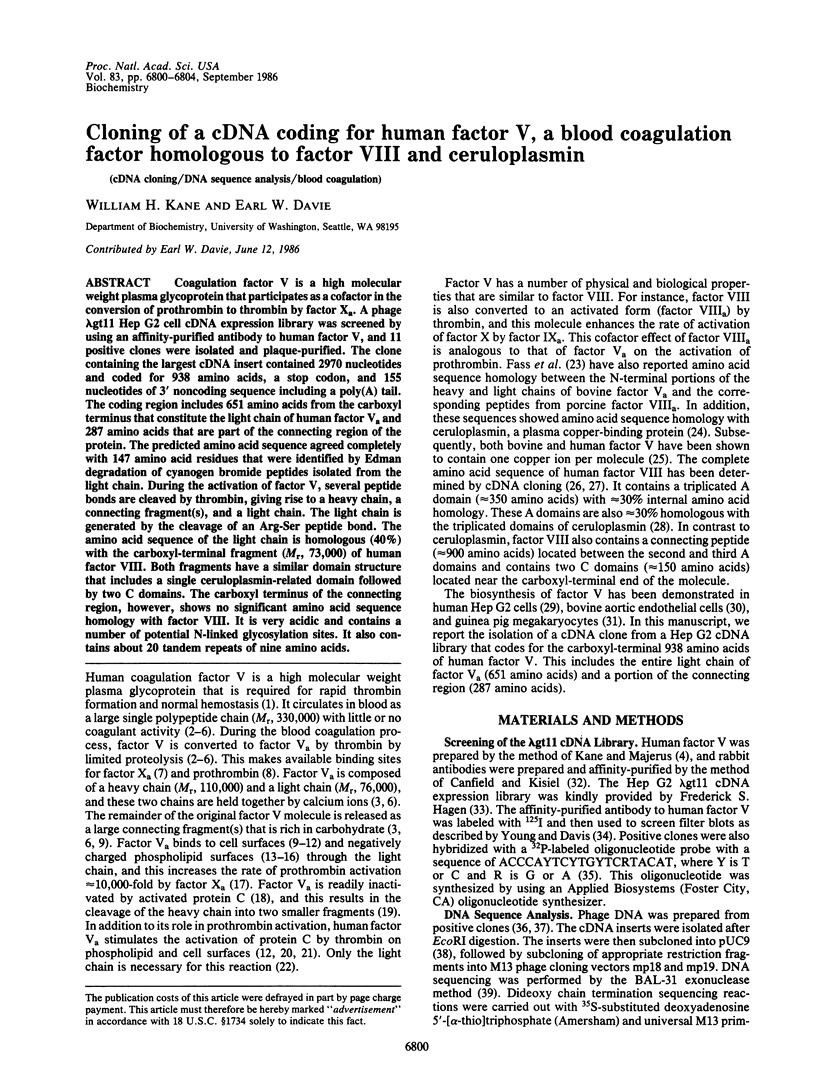
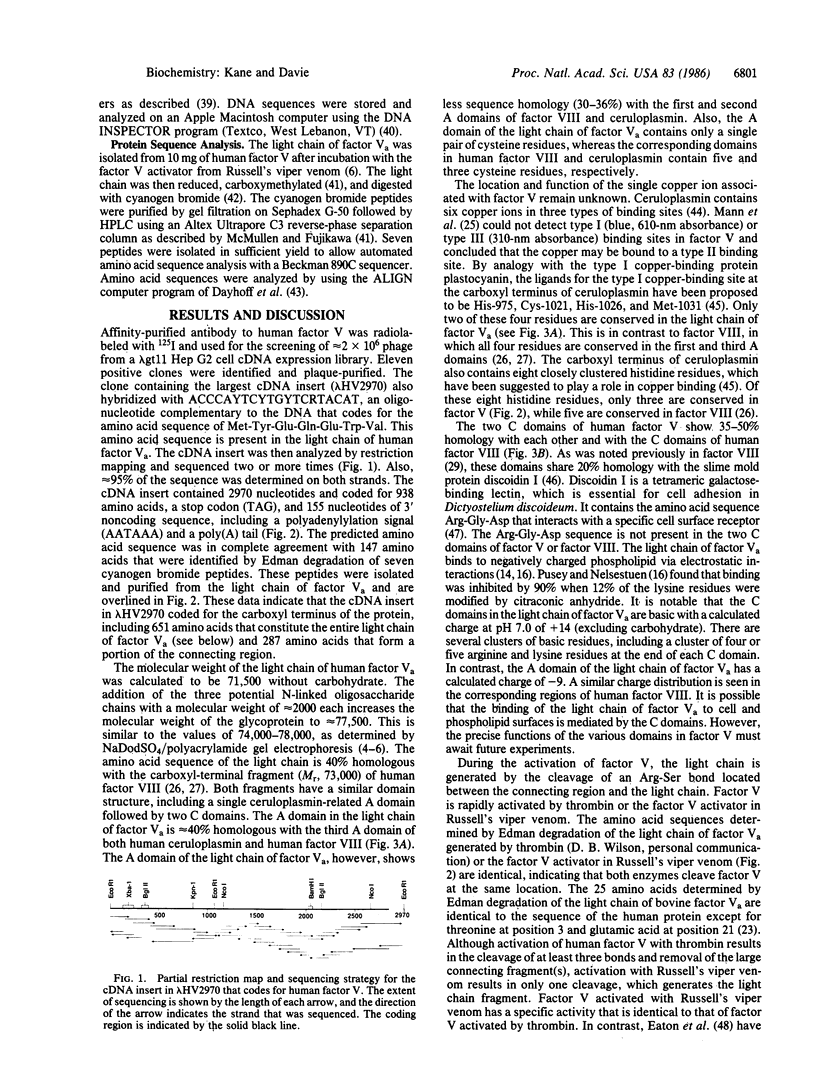
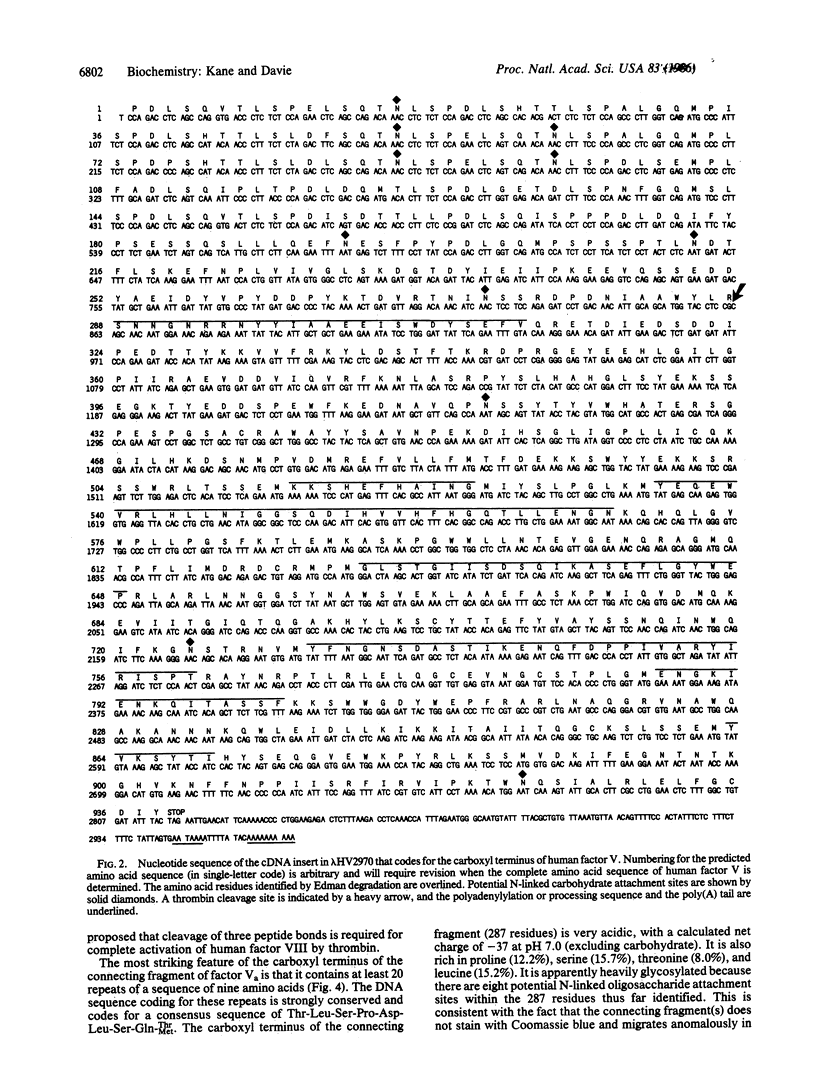
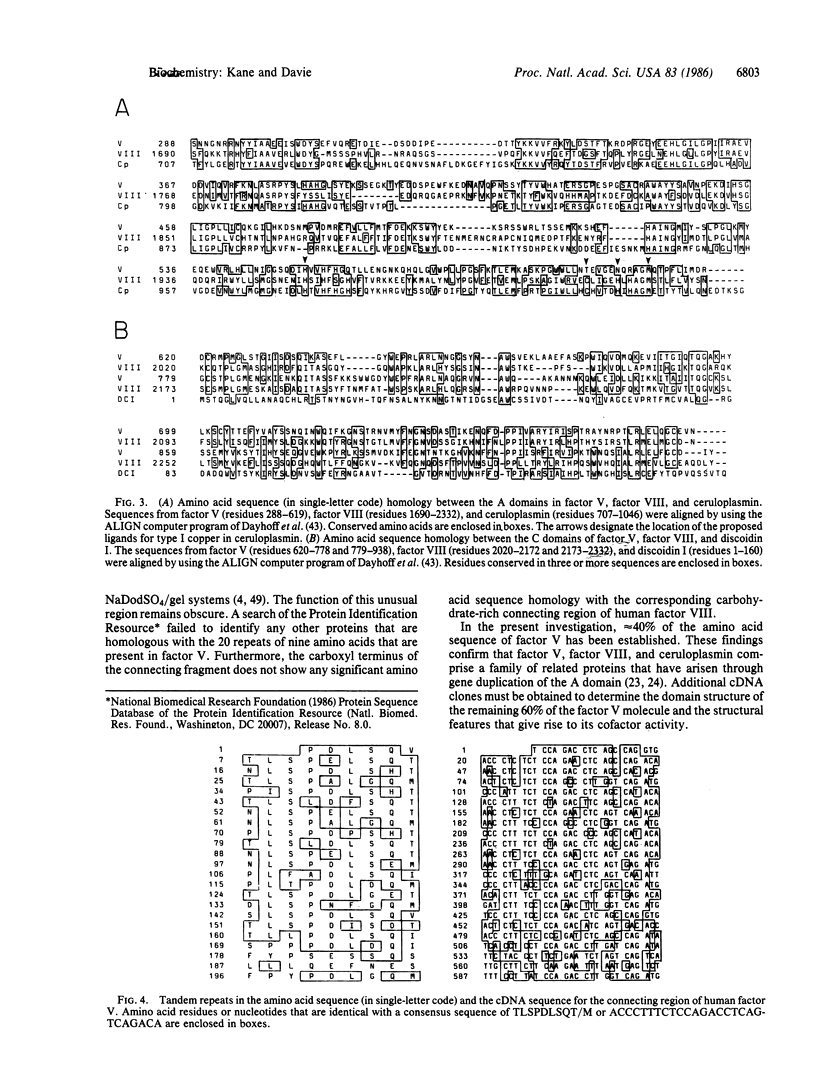
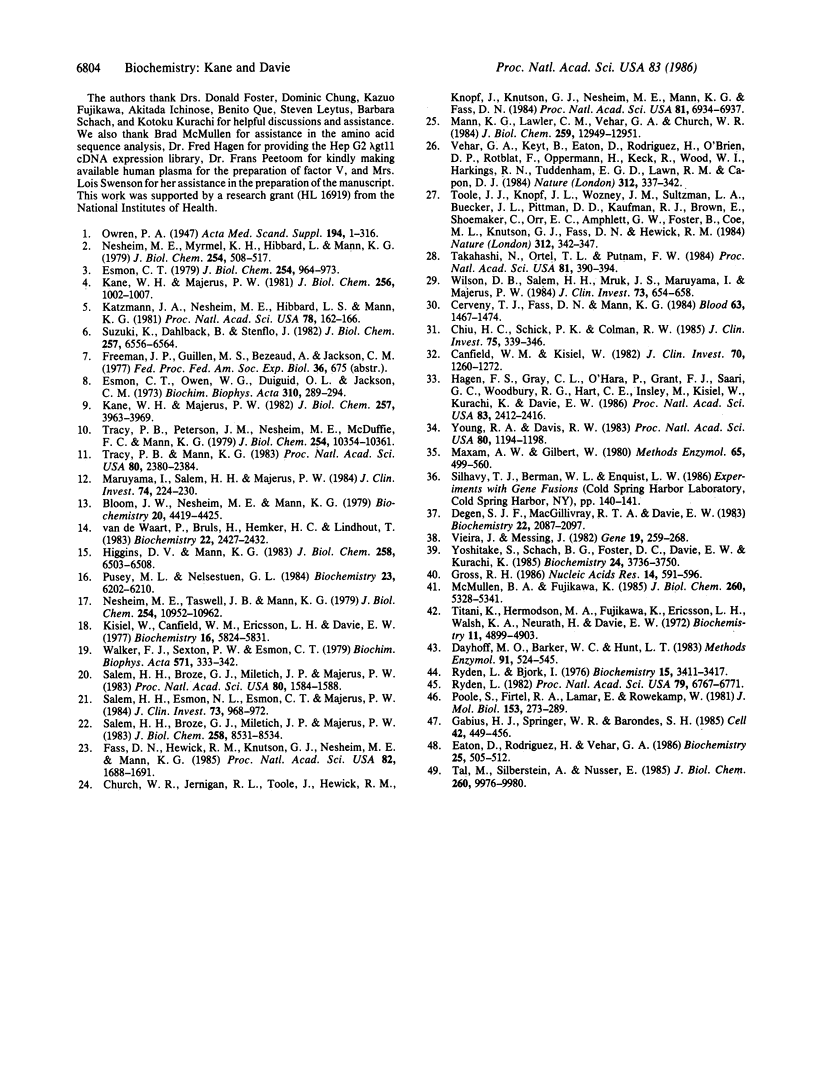
Selected References
These references are in PubMed. This may not be the complete list of references from this article.
- Bloom J. W., Nesheim M. E., Mann K. G. Phospholipid-binding properties of bovine factor V and factor Va. Biochemistry. 1979 Oct 2;18(20):4419–4425. doi: 10.1021/bi00587a023. [DOI] [PubMed] [Google Scholar]
- Canfield W. M., Kisiel W. Evidence of normal functional levels of activated protein C inhibitor in combined Factor V/VIII deficiency disease. J Clin Invest. 1982 Dec;70(6):1260–1272. doi: 10.1172/JCI110725. [DOI] [PMC free article] [PubMed] [Google Scholar]
- Cerveny T. J., Fass D. N., Mann K. G. Synthesis of coagulation factor V by cultured aortic endothelium. Blood. 1984 Jun;63(6):1467–1474. [PubMed] [Google Scholar]
- Chiu H. C., Schick P. K., Colman R. W. Biosynthesis of factor V in isolated guinea pig megakaryocytes. J Clin Invest. 1985 Feb;75(2):339–346. doi: 10.1172/JCI111706. [DOI] [PMC free article] [PubMed] [Google Scholar]
- Church W. R., Jernigan R. L., Toole J., Hewick R. M., Knopf J., Knutson G. J., Nesheim M. E., Mann K. G., Fass D. N. Coagulation factors V and VIII and ceruloplasmin constitute a family of structurally related proteins. Proc Natl Acad Sci U S A. 1984 Nov;81(22):6934–6937. doi: 10.1073/pnas.81.22.6934. [DOI] [PMC free article] [PubMed] [Google Scholar]
- Dayhoff M. O., Barker W. C., Hunt L. T. Establishing homologies in protein sequences. Methods Enzymol. 1983;91:524–545. doi: 10.1016/s0076-6879(83)91049-2. [DOI] [PubMed] [Google Scholar]
- Degen S. J., MacGillivray R. T., Davie E. W. Characterization of the complementary deoxyribonucleic acid and gene coding for human prothrombin. Biochemistry. 1983 Apr 26;22(9):2087–2097. doi: 10.1021/bi00278a008. [DOI] [PubMed] [Google Scholar]
- Eaton D., Rodriguez H., Vehar G. A. Proteolytic processing of human factor VIII. Correlation of specific cleavages by thrombin, factor Xa, and activated protein C with activation and inactivation of factor VIII coagulant activity. Biochemistry. 1986 Jan 28;25(2):505–512. doi: 10.1021/bi00350a035. [DOI] [PubMed] [Google Scholar]
- Esmon C. T., Owen W. G., Duiguid D. L., Jackson C. M. The action of thrombin on blood clotting factor V: conversion of factor V to a prothrombin-binding protein. Biochim Biophys Acta. 1973 May 17;310(1):289–294. doi: 10.1016/0005-2795(73)90034-2. [DOI] [PubMed] [Google Scholar]
- Esmon C. T. The subunit structure of thrombin-activated factor V. Isolation of activated factor V, separation of subunits, and reconstitution of biological activity. J Biol Chem. 1979 Feb 10;254(3):964–973. [PubMed] [Google Scholar]
- Fass D. N., Hewick R. M., Knutson G. J., Nesheim M. E., Mann K. G. Internal duplication and sequence homology in factors V and VIII. Proc Natl Acad Sci U S A. 1985 Mar;82(6):1688–1691. doi: 10.1073/pnas.82.6.1688. [DOI] [PMC free article] [PubMed] [Google Scholar]
- Gabius H. J., Springer W. R., Barondes S. H. Receptor for the cell binding site of discoidin I. Cell. 1985 Sep;42(2):449–456. doi: 10.1016/0092-8674(85)90102-3. [DOI] [PubMed] [Google Scholar]
- Gross R. H. A DNA sequence analysis program for the Apple Macintosh. Nucleic Acids Res. 1986 Jan 10;14(1):591–596. doi: 10.1093/nar/14.1.591. [DOI] [PMC free article] [PubMed] [Google Scholar]
- Hagen F. S., Gray C. L., O'Hara P., Grant F. J., Saari G. C., Woodbury R. G., Hart C. E., Insley M., Kisiel W., Kurachi K. Characterization of a cDNA coding for human factor VII. Proc Natl Acad Sci U S A. 1986 Apr;83(8):2412–2416. doi: 10.1073/pnas.83.8.2412. [DOI] [PMC free article] [PubMed] [Google Scholar]
- Higgins D. L., Mann K. G. The interaction of bovine factor V and factor V-derived peptides with phospholipid vesicles. J Biol Chem. 1983 May 25;258(10):6503–6508. [PubMed] [Google Scholar]
- Kane W. H., Majerus P. W. Purification and characterization of human coagulation factor V. J Biol Chem. 1981 Jan 25;256(2):1002–1007. [PubMed] [Google Scholar]
- Kane W. H., Majerus P. W. The interaction of human coagulation factor Va with platelets. J Biol Chem. 1982 Apr 10;257(7):3963–3969. [PubMed] [Google Scholar]
- Katzmann J. A., Nesheim M. E., Hibbard L. S., Mann K. G. Isolation of functional human coagulation factor V by using a hybridoma antibody. Proc Natl Acad Sci U S A. 1981 Jan;78(1):162–166. doi: 10.1073/pnas.78.1.162. [DOI] [PMC free article] [PubMed] [Google Scholar]
- Kisiel W., Canfield W. M., Ericsson L. H., Davie E. W. Anticoagulant properties of bovine plasma protein C following activation by thrombin. Biochemistry. 1977 Dec 27;16(26):5824–5831. doi: 10.1021/bi00645a029. [DOI] [PubMed] [Google Scholar]
- Mann K. G., Lawler C. M., Vehar G. A., Church W. R. Coagulation Factor V contains copper ion. J Biol Chem. 1984 Nov 10;259(21):12949–12951. [PubMed] [Google Scholar]
- Maruyama I., Salem H. H., Majerus P. W. Coagulation factor Va binds to human umbilical vein endothelial cells and accelerates protein C activation. J Clin Invest. 1984 Jul;74(1):224–230. doi: 10.1172/JCI111405. [DOI] [PMC free article] [PubMed] [Google Scholar]
- Maxam A. M., Gilbert W. Sequencing end-labeled DNA with base-specific chemical cleavages. Methods Enzymol. 1980;65(1):499–560. doi: 10.1016/s0076-6879(80)65059-9. [DOI] [PubMed] [Google Scholar]
- McMullen B. A., Fujikawa K. Amino acid sequence of the heavy chain of human alpha-factor XIIa (activated Hageman factor). J Biol Chem. 1985 May 10;260(9):5328–5341. [PubMed] [Google Scholar]
- Nesheim M. E., Myrmel K. H., Hibbard L., Mann K. G. Isolation and characterization of single chain bovine factor V. J Biol Chem. 1979 Jan 25;254(2):508–517. [PubMed] [Google Scholar]
- Nesheim M. E., Taswell J. B., Mann K. G. The contribution of bovine Factor V and Factor Va to the activity of prothrombinase. J Biol Chem. 1979 Nov 10;254(21):10952–10962. [PubMed] [Google Scholar]
- Poole S., Firtel R. A., Lamar E., Rowekamp W. Sequence and expression of the discoidin I gene family in Dictyostelium discoideum. J Mol Biol. 1981 Dec 5;153(2):273–289. doi: 10.1016/0022-2836(81)90278-3. [DOI] [PubMed] [Google Scholar]
- Pusey M. L., Nelsestuen G. L. Membrane binding properties of blood coagulation Factor V and derived peptides. Biochemistry. 1984 Dec 4;23(25):6202–6210. doi: 10.1021/bi00320a048. [DOI] [PubMed] [Google Scholar]
- Rydén L., Björk I. Reinvestigation of some physicochemical and chemical properties of human ceruloplasmin (ferroxidase). Biochemistry. 1976 Aug 10;15(16):3411–3417. doi: 10.1021/bi00661a003. [DOI] [PubMed] [Google Scholar]
- Rydén L. Model of the active site in the blue oxidases based on the ceruloplasmin-plastocyanin homology. Proc Natl Acad Sci U S A. 1982 Nov;79(22):6767–6771. doi: 10.1073/pnas.79.22.6767. [DOI] [PMC free article] [PubMed] [Google Scholar]
- Salem H. H., Broze G. J., Miletich J. P., Majerus P. W. Human coagulation factor Va is a cofactor for the activation of protein C. Proc Natl Acad Sci U S A. 1983 Mar;80(6):1584–1588. doi: 10.1073/pnas.80.6.1584. [DOI] [PMC free article] [PubMed] [Google Scholar]
- Salem H. H., Broze G. J., Miletich J. P., Majerus P. W. The light chain of factor Va contains the activity of factor Va that accelerates protein C activation by thrombin. J Biol Chem. 1983 Jul 25;258(14):8531–8534. [PubMed] [Google Scholar]
- Salem H. H., Esmon N. L., Esmon C. T., Majerus P. W. Effects of thrombomodulin and coagulation Factor Va-light chain on protein C activation in vitro. J Clin Invest. 1984 Apr;73(4):968–972. doi: 10.1172/JCI111321. [DOI] [PMC free article] [PubMed] [Google Scholar]
- Suzuki K., Dahlbäck B., Stenflo J. Thrombin-catalyzed activation of human coagulation factor V. J Biol Chem. 1982 Jun 10;257(11):6556–6564. [PubMed] [Google Scholar]
- Takahashi N., Ortel T. L., Putnam F. W. Single-chain structure of human ceruloplasmin: the complete amino acid sequence of the whole molecule. Proc Natl Acad Sci U S A. 1984 Jan;81(2):390–394. doi: 10.1073/pnas.81.2.390. [DOI] [PMC free article] [PubMed] [Google Scholar]
- Tal M., Silberstein A., Nusser E. Why does Coomassie Brilliant Blue R interact differently with different proteins? A partial answer. J Biol Chem. 1985 Aug 25;260(18):9976–9980. [PubMed] [Google Scholar]
- Titani K., Hermodson M. A., Fujikawa K., Ericsson L. H., Walsh K. A., Neurath H., Davie E. W. Bovine factor X 1a (activated Stuart factor). Evidence of homology with mammalian serine proteases. Biochemistry. 1972 Dec 19;11(26):4899–4903. doi: 10.1021/bi00776a004. [DOI] [PubMed] [Google Scholar]
- Toole J. J., Knopf J. L., Wozney J. M., Sultzman L. A., Buecker J. L., Pittman D. D., Kaufman R. J., Brown E., Shoemaker C., Orr E. C. Molecular cloning of a cDNA encoding human antihaemophilic factor. Nature. 1984 Nov 22;312(5992):342–347. doi: 10.1038/312342a0. [DOI] [PubMed] [Google Scholar]
- Tracy P. B., Mann K. G. Prothrombinase complex assembly on the platelet surface is mediated through the 74,000-dalton component of factor Va. Proc Natl Acad Sci U S A. 1983 Apr;80(8):2380–2384. doi: 10.1073/pnas.80.8.2380. [DOI] [PMC free article] [PubMed] [Google Scholar]
- Tracy P. B., Peterson J. M., Nesheim M. E., McDuffie F. C., Mann K. G. Interaction of coagulation factor V and factor Va with platelets. J Biol Chem. 1979 Oct 25;254(20):10354–10361. [PubMed] [Google Scholar]
- Vehar G. A., Keyt B., Eaton D., Rodriguez H., O'Brien D. P., Rotblat F., Oppermann H., Keck R., Wood W. I., Harkins R. N. Structure of human factor VIII. Nature. 1984 Nov 22;312(5992):337–342. doi: 10.1038/312337a0. [DOI] [PubMed] [Google Scholar]
- Vieira J., Messing J. The pUC plasmids, an M13mp7-derived system for insertion mutagenesis and sequencing with synthetic universal primers. Gene. 1982 Oct;19(3):259–268. doi: 10.1016/0378-1119(82)90015-4. [DOI] [PubMed] [Google Scholar]
- Walker F. J., Sexton P. W., Esmon C. T. The inhibition of blood coagulation by activated Protein C through the selective inactivation of activated Factor V. Biochim Biophys Acta. 1979 Dec 7;571(2):333–342. doi: 10.1016/0005-2744(79)90103-7. [DOI] [PubMed] [Google Scholar]
- Wilson D. B., Salem H. H., Mruk J. S., Maruyama I., Majerus P. W. Biosynthesis of coagulation Factor V by a human hepatocellular carcinoma cell line. J Clin Invest. 1984 Mar;73(3):654–658. doi: 10.1172/JCI111256. [DOI] [PMC free article] [PubMed] [Google Scholar]
- Yoshitake S., Schach B. G., Foster D. C., Davie E. W., Kurachi K. Nucleotide sequence of the gene for human factor IX (antihemophilic factor B). Biochemistry. 1985 Jul 2;24(14):3736–3750. doi: 10.1021/bi00335a049. [DOI] [PubMed] [Google Scholar]
- Young R. A., Davis R. W. Efficient isolation of genes by using antibody probes. Proc Natl Acad Sci U S A. 1983 Mar;80(5):1194–1198. doi: 10.1073/pnas.80.5.1194. [DOI] [PMC free article] [PubMed] [Google Scholar]
- van de Waart P., Bruls H., Hemker H. C., Lindhout T. Interaction of bovine blood clotting factor Va and its subunits with phospholipid vesicles. Biochemistry. 1983 May 10;22(10):2427–2432. doi: 10.1021/bi00279a019. [DOI] [PubMed] [Google Scholar]


